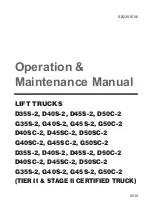
4. SEAT ADJUSTMENT
4. SEAT ADJUSTMENT
BUCKLING UP
BUCKLING UP
2)
2)
Be sure that you put on the seat belt. Connect and adjust the
seat belt strap to a snug, comfortable position.
Always wear your seat belt when operating a lift truck.
Always wear your seat belt when operating a lift truck.
Failure to wear seat belt will result in injury or death in an
Failure to wear seat belt will result in injury or death in an
event of an accident.
event of an accident.
Always check the condition of the seat belt and mounting
Always check the condition of the seat belt and mounting
hardware before operating the truck.
hardware before operating the truck.
Replace the seat belt at least once every three years,
Replace the seat belt at least once every three years,
regardless of appearance.
regardless of appearance.
(1)
SEAT ADJUSTMENT
SEAT ADJUSTMENT
The seat is adjustable to fit the contours of the operator's body. It will reduce operator fatigue due
to long work hours and enhance work efficiency.
G
B
D
E
F
A
C
Forward / Backward adjustment
Forward / Backward adjustment
Pull lever A to adjust seat forward or backward.
Upward / Downward adjustment
Upward / Downward adjustment
Push or pull the height adjuster lever (B) to
adjust seat upward or downward.
Reclining adjustment
Reclining adjustment
Pull lever (D) to adjust seat back rest.
Arm rest adjustment
Arm rest adjustment
This can be adjusted by turning the handle (F)
to right and left.
Cushion adjustment (E)
Cushion adjustment (E)
Adjusting handle to the operator's weight.
Shoulder rest (C)
Shoulder rest (C)
The shoulder rest can be adjust to upward.
Lumbar support (G)
Lumbar support (G)
The curvature of the backrest cushion can be
adjusted by turning the adjustment knob.
①
1)
1)
(1)
(1)
(2)
(2)
(3)
(3)
(4)
(4)
(5)
(5)
(6)
(6)
(7)
(7)
160D9LCD50
①
160D7OM11
5-9





































